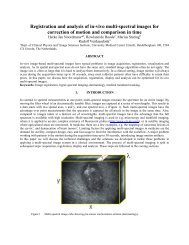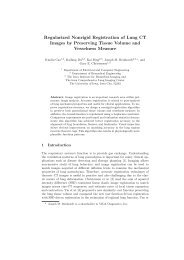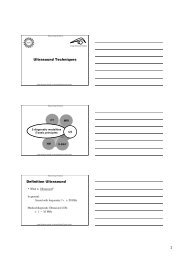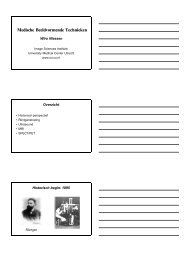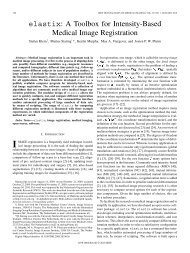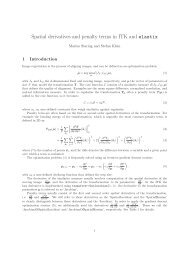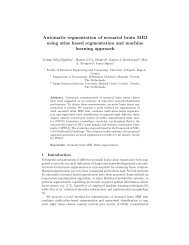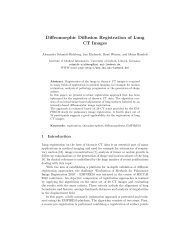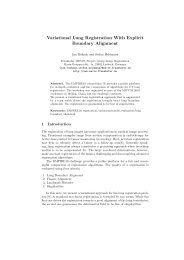Assessing the Skeletal Age From a Hand Radiograph: Automating ...
Assessing the Skeletal Age From a Hand Radiograph: Automating ...
Assessing the Skeletal Age From a Hand Radiograph: Automating ...
Create successful ePaper yourself
Turn your PDF publications into a flip-book with our unique Google optimized e-Paper software.
<strong>Assessing</strong> <strong>the</strong> <strong>Skeletal</strong> <strong>Age</strong> <strong>From</strong> a <strong>Hand</strong> <strong>Radiograph</strong>:<br />
<strong>Automating</strong> <strong>the</strong> Tanner-Whitehouse Method<br />
M. Niemeijer a , B. van Ginneken a , C.A. Maas a , F.J.A. Beek b and M.A. Viergever a<br />
a Image Sciences Institute, University Medical Center Utrecht, The Ne<strong>the</strong>rlands<br />
b Dept. of Radiology, University Medical Center Utrecht, The Ne<strong>the</strong>rlands<br />
ABSTRACT<br />
The skeletal maturity of children is usually assessed from a standard radiograph of <strong>the</strong> left hand and wrist.<br />
An established clinical method to determine <strong>the</strong> skeletal maturity is <strong>the</strong> Tanner-Whitehouse (TW2) method.<br />
This method divides <strong>the</strong> skeletal development into several stages (labelled A,B, ...,I). We are developing an<br />
automated system based on this method. In this work we focus on assigning a stage to one region of interest<br />
(ROI), <strong>the</strong> middle phalanx of <strong>the</strong> third finger. We classify each ROI as follows. A number of ROIs which have<br />
been assigned a certain stage by a radiologist are used to construct a mean image for that stage. For a new<br />
input ROI, landmarks are detected using an Active Shape Model. These are used to align <strong>the</strong> mean images with<br />
<strong>the</strong> input image. Subsequently <strong>the</strong> correlation between each transformed mean stage image and <strong>the</strong> input is<br />
calculated. The input ROI can be assigned to <strong>the</strong> stage with <strong>the</strong> highest correlation directly, or <strong>the</strong> values can<br />
be used as features in a classifier. The method was tested on 71 cases ranging from stage E to I. The ROI was<br />
staged correctly in 73.2% of all cases and in 97.2% of all incorrectly staged cases <strong>the</strong> error was not more than<br />
one stage.<br />
Keywords: <strong>Skeletal</strong> maturity, active shape models, computer-aided diagnosis, hand radiographs<br />
1. INTRODUCTION<br />
<strong>Skeletal</strong> maturity (or skeletal age, or bone age) assessment is a common procedure in pediatric radiology. Automatic<br />
skeletal age assessment has <strong>the</strong> potential to reduce <strong>the</strong> time required to examine <strong>the</strong> image and to increase<br />
<strong>the</strong> repeatability of <strong>the</strong> analysis. <strong>Skeletal</strong> maturity is usually determined from a radiograph of <strong>the</strong> left hand, in<br />
which several ossification centers (see Figure 1) can be identified.<br />
The skeletal age can be compared to <strong>the</strong> chronological age; a big discrepancy between <strong>the</strong>se two can indicate<br />
an atypical skeletal development. The procedure is often used in <strong>the</strong> management and diagnosis of endocrine<br />
disorders and it can also serve as an indication of <strong>the</strong> <strong>the</strong>rapeutic effect of treatment. Generally it can indicate<br />
whe<strong>the</strong>r <strong>the</strong> growth of a patient is accelerating or decreasing. In many cases <strong>the</strong> decision whe<strong>the</strong>r to treat a<br />
patient with growth hormones depends on <strong>the</strong> outcome of this test.<br />
At <strong>the</strong> moment <strong>the</strong> two methods that are most widely used for manual determination of <strong>the</strong> skeletal maturity<br />
are <strong>the</strong> Tanner and Whitehouse (TW2) 1 and <strong>the</strong> Greulich and Pyle (G&P) 2 method. The Greulich and Pyle<br />
method involves a complex comparison of all <strong>the</strong> bones in <strong>the</strong> hand and wrist against reference radiographs of<br />
different ages. In <strong>the</strong> Tanner and Whitehouse method twenty regions of interest (ROIs) in <strong>the</strong> hand are considered.<br />
The development of each ROI is divided into discrete stages and each stage is given a letter (A,B,C,D, ...,I).<br />
Figure 1. Example of several different stages of development of an ossification center in <strong>the</strong> finger.
A numerical score is associated with each stage of each bone. By adding <strong>the</strong> scores of all ROIs, <strong>the</strong> an overall<br />
maturity score is obtained. The TW2 method has a modular structure which makes it suitable for automation.<br />
Previous research into assigning a certain skeletal development stage or score to a hand radiograph or a region<br />
in <strong>the</strong> image has focused on making particular measurements, for example <strong>the</strong> width or length of certain bones,<br />
and relate <strong>the</strong>se measurements to a certain skeletal age. Then one can train a classifier and use it to assign <strong>the</strong><br />
measurements of new cases to a certain skeletal age or TW2 score (e.g. Pietka 345 and Gross 6 ). Tanner 7 directly<br />
estimated <strong>the</strong> TW2 stage of a bone in a system called CASAS. This analysis was based on features extracted<br />
from <strong>the</strong> Fourier transform of <strong>the</strong> ROI.<br />
In this paper we present a new automatic method to assign skeletal development stages (TW2 stages) to<br />
bones in <strong>the</strong> hand. It makes use of both shape and appearance information. We use an Active Shape Model<br />
(ASM), a segmentation method developed by Cootes and Taylor 8 to segment <strong>the</strong> outline of <strong>the</strong> bones.<br />
In Section 2 we describe our data. Section 3 outlines our method. In Section 4 experiments and results are<br />
given. We end with a discussion in Section 5.<br />
2. MATERIALS<br />
We used a database of 243 hand radiographs from <strong>the</strong> academic hospital of <strong>the</strong> Katholieke Universiteit Leuven,<br />
Belgium. The set contains a random mix between female and male subjects. The age of subjects varies from 1<br />
to 21 years, but most subjects were between 7 and 16 years old. The images were acquired with a digital X-ray<br />
unit. The resolution was ei<strong>the</strong>r 1514 by 2044 pixels or 2040 by 2570 pixels.<br />
Each of <strong>the</strong> images was analyzed with <strong>the</strong> TW2 method. The ratings were obtained from radiologists who<br />
read <strong>the</strong> images as part of routine clinical practice.<br />
We selected 181 cases to assess <strong>the</strong> stage of <strong>the</strong> middle phalanx of <strong>the</strong> third finger. Stages A to D were<br />
excluded because too few examples were available for training. Also for stage H <strong>the</strong>re were not enough examples<br />
so we used <strong>the</strong> same cases for training and testing. For all o<strong>the</strong>r stages train and test cases were not mixed. In<br />
total 119 cases were used for training and 71 for testing. Table 2 lists <strong>the</strong> numbers per stage.<br />
3. AUTOMATIC DETERMINATION OF THE TW2 STAGE<br />
Our method to stage an ROI consists of <strong>the</strong> following steps:<br />
1. Construct mean images for each TW2 stage.<br />
2. Train an active shape model (ASM) to segment a query image.<br />
3. Segment a query image with <strong>the</strong> ASM and use this to align <strong>the</strong> mean images to it.<br />
4. Compute <strong>the</strong> correlation between a query image and <strong>the</strong> mean images<br />
5. Assign a TW2 stage based on <strong>the</strong>se correlation coefficients.<br />
In <strong>the</strong> first step images are produced that represent <strong>the</strong> mean shape and appearance of an ROI in each TW2<br />
stage. The ASM developed in <strong>the</strong> second step is used to determine <strong>the</strong> shape and location of <strong>the</strong> bones in a<br />
query ROI (that is, an ROI of which <strong>the</strong> TW2 stage is unknown) so that this ROI can be aligned with each of<br />
<strong>the</strong> mean images, in <strong>the</strong> third step. Finally we compute <strong>the</strong> correlation between a fixed area around <strong>the</strong> bones<br />
in <strong>the</strong> mean images and <strong>the</strong> query ROI. These correlation coefficients are used to determine <strong>the</strong> TW2 stage in<br />
Stage E F G H I all<br />
Nr of images used for training 32 33 30 9 15 119<br />
Nr of images used for testing 20 15 15 9 12 71<br />
Table 1. The number of images, per stage, used in <strong>the</strong> experiments. In all cases test and train data are different except<br />
for <strong>the</strong> nine images in stage H.
<strong>the</strong> final step. Note that <strong>the</strong> first and second step have to be done only once in a training procedure. The mean<br />
images and <strong>the</strong> ASM produced in <strong>the</strong>se steps are used for testing in step 3. A detailed explanation of <strong>the</strong> five<br />
steps is presented in <strong>the</strong> next sections.<br />
3.1. Constructing <strong>the</strong> mean images<br />
The mean images for each TW2 stage are produced from a set of training ROIs for each stage. All ROIs are<br />
manually selected and rotated so that <strong>the</strong> bones are in an upright position. Subsequently, a set of landmarks is<br />
indicated in each image manually. For each landmark <strong>the</strong> mean position is computed. The images are <strong>the</strong>n aligned<br />
by Procrustes analysis. This determines a translation, rotation and scaling for each image which minimizes <strong>the</strong><br />
sum of squared distances between <strong>the</strong> landmarks and <strong>the</strong>ir mean position. There are analytic solutions for this,<br />
but we employ an iterative approach proposed by Cootes. 8<br />
Once all images have been aligned, <strong>the</strong>y are simply added to produce a mean image for that particular stage.<br />
This procedure is illustrated in Figure 2). The resulting mean images are displayed in Figure 3. Next to <strong>the</strong><br />
mean images <strong>the</strong> reference images from <strong>the</strong> TW2 atlas are placed. The resemblance is striking. The reference<br />
images from <strong>the</strong> TW2 method are single radiographs that have been selected as typical examples of a stage.<br />
3.2. Training <strong>the</strong> active shape model<br />
In subsequent steps, we need to bring a query ROI image and a mean image of a stage in registration. We do<br />
this in two steps. First, we segment <strong>the</strong> bones in <strong>the</strong> query image with an ASM. Then we know <strong>the</strong> position of<br />
a fixed number of corresponding points in both images and we align <strong>the</strong>m with Procrustes analysis. Therefore<br />
we train an ASM with all <strong>the</strong> training images used to construct <strong>the</strong> mean images, a total of 119.<br />
The ASM segmentation algorithm was proposed by Cootes and Taylor 8 and has found widespread application<br />
in medical image segmentation. The algorithm contains a large number of parameters. We found that <strong>the</strong> choice<br />
of <strong>the</strong>se parameters is critical for good performance.<br />
First of all, <strong>the</strong> choice which points to use to delineate <strong>the</strong> objects is important. Points should be anatomical<br />
landmarks that are easy to locate in each image, such as corners or o<strong>the</strong>r places of high contour curvature. There<br />
are not enough of <strong>the</strong>se positions available to give an accurate description of <strong>the</strong> shape, <strong>the</strong>refore we add equally<br />
+<br />
(a)<br />
(b)<br />
Figure 2. (a) The orthogonal projection of a number of different images of stage F results in a mean image for that<br />
stage. (b) The mean image for stage F.
D E F<br />
G H I<br />
Figure 3. Mean images for stages D to I of <strong>the</strong> middle phalanx of <strong>the</strong> third finger. On <strong>the</strong> left of each pair <strong>the</strong> TW2<br />
atlas reference image is shown. On <strong>the</strong> right <strong>the</strong> mean image used in our experiments.<br />
spaced intermediate points along a manually traced border of <strong>the</strong> object between <strong>the</strong>se anatomical landmarks.<br />
We use <strong>the</strong> outline of <strong>the</strong> metaphysis, epiphysis and diaphysis.<br />
Figure 4 shows <strong>the</strong> anatomical landmarks we have used. Some points, like 4, 11 and 18, are located where<br />
<strong>the</strong> longitudinal axis of <strong>the</strong> finger crosses <strong>the</strong> object border. O<strong>the</strong>rs, like 1, 7, 15 and 21, are located at <strong>the</strong><br />
outer parts of <strong>the</strong> ROI. Points like 3, 5, 9, 10, 12 and 13 are set at <strong>the</strong> outer most points of <strong>the</strong> meta and<br />
epiphysis. These positions could be used in determining <strong>the</strong> ratio of <strong>the</strong> width of <strong>the</strong> meta and epiphysis which<br />
is an important indicator of skeletal age in <strong>the</strong> earlier stages. All <strong>the</strong> points are easy to locate in each image.<br />
When we have determined all <strong>the</strong> anatomical landmarks we add equidistantly sampled points between <strong>the</strong>n<br />
to <strong>the</strong> shape. Varying <strong>the</strong> amount of <strong>the</strong>se points on an edge allows us to heighten or lower <strong>the</strong> ”weight” of that<br />
edge. We add a total of 70 intermediate points to <strong>the</strong> shape, which results in a shape of 81 landmarks. A large<br />
number of intermediate points is added to <strong>the</strong> epiphysis because that is a very important structure.<br />
We empirically determined optimal settings for <strong>the</strong> parameters in <strong>the</strong> ASM scheme. This can have a large<br />
influence on its performance, as illustrated in Figure 5, where it is demonstrated that visiting a large range of<br />
1<br />
7<br />
2<br />
3 4<br />
9 8 14<br />
10<br />
11<br />
6<br />
5<br />
13<br />
12<br />
16<br />
17<br />
18 19<br />
20<br />
15<br />
21<br />
Figure 4. A typical ROI with <strong>the</strong> fixed model points marked on <strong>the</strong> bone contour.
Figure 5. Varying n s between 2 and 4 had <strong>the</strong> effect shown here. On <strong>the</strong> left we see <strong>the</strong> segmentation result with n s =2,<br />
on <strong>the</strong> right with n s = 4. The segmentation on <strong>the</strong> right might appear better but <strong>the</strong> dim shadow under <strong>the</strong> epiphysis<br />
must also be segmented.<br />
candidate positions for each landmark during each iteration deteriorates <strong>the</strong> result because <strong>the</strong> border is often<br />
attracted to <strong>the</strong> wrong edge in <strong>the</strong> image.<br />
The construction of <strong>the</strong> mean images, toge<strong>the</strong>r with <strong>the</strong> determination of <strong>the</strong> position of <strong>the</strong> landmarks in<br />
each mean image, and <strong>the</strong> development of an ASM from all training cases completes <strong>the</strong> training stage of <strong>the</strong><br />
algorithm.<br />
3.3. Segmentation and alignment of query images<br />
The first step in <strong>the</strong> analysis of a query image is to segment <strong>the</strong> bones using <strong>the</strong> ASM. This gives us <strong>the</strong> position<br />
of all landmarks in <strong>the</strong> query image. The next step is to bring each mean image into alignment with <strong>the</strong> query<br />
image. This is done with Procrustes analysis. Note that this only translates, scales and rotates <strong>the</strong> mean image<br />
and thus does not alter <strong>the</strong> shape of <strong>the</strong> bones in <strong>the</strong> mean image. A good alignment between both shapes is<br />
<strong>the</strong>refore only achieved if <strong>the</strong> bones in <strong>the</strong> query image have a shape similar to <strong>the</strong> mean image.<br />
3.4. Correlation between query ROI and mean images<br />
Once a mean image and a query image have been aligned we use <strong>the</strong> correlation between a part of both images<br />
to indicate <strong>the</strong> similarity between <strong>the</strong>m. This part is specified as follows. We take an area that is as wide as <strong>the</strong><br />
ROI and has a height of one third of <strong>the</strong> ROI and center this on <strong>the</strong> 14th and 70th point in <strong>the</strong> query image<br />
shape. Figure 6 illustrates <strong>the</strong> resulting areas.<br />
Correlation ρ of two jointly distributed variables X and Y is defined as<br />
ρ =<br />
Cov(X, Y )<br />
√<br />
Var(X)Var(Y )<br />
(1)<br />
The jointly distributed variables in this case are <strong>the</strong> grey values of <strong>the</strong> pixels in both <strong>the</strong> mean and <strong>the</strong> query<br />
image.
second observer<br />
E F G H I<br />
E 16 2 0 0 0<br />
F 4 11 4 0 0<br />
G 0 2 11 0 0<br />
H 0 0 0 9 2<br />
I 0 0 0 0 10<br />
maximum correlation<br />
E F G H I<br />
E 17 4 0 0 0<br />
F 3 8 0 0 0<br />
G 0 2 13 3 0<br />
H 0 0 1 6 4<br />
I 0 1 1 0 8<br />
80.3% correct 73.2% correct<br />
100% correct within one stage 97.2% correct within one stage<br />
1-NN<br />
E F G H I<br />
E 18 2 0 0 0<br />
F 7 6 2 0 0<br />
G 1 8 5 1 0<br />
H 0 0 3 4 2<br />
I 0 0 1 2 9<br />
LDC<br />
E F G H I<br />
E 17 3 0 0 0<br />
F 3 10 2 0 0<br />
G 0 3 9 1 2<br />
H 0 0 3 5 1<br />
I 0 0 1 0 11<br />
59.2% correct 73.2% correct<br />
97.2% correct within one stage 95.8% correct within one stage<br />
Table 2. Confusion matrices that compare each system with <strong>the</strong> ground truth. Top-left <strong>the</strong> results of a second observer.<br />
Top-right <strong>the</strong> system that assigns an input to <strong>the</strong> stage with maximum correlation. Bottom-left a 1-Nearest Neighbor<br />
classifier. Bottom-right a Linear Discriminant Classifier.<br />
3.5. Assigning a TW2 stage<br />
<strong>From</strong> <strong>the</strong> procedure outlined above, we obtain 5 correlation values for a query image. The simplest method to<br />
determine a TW2 stage would be to take <strong>the</strong> stage with <strong>the</strong> highest correlation. Alternatively, <strong>the</strong> 5 values could<br />
be used as features and a classifier could be trained to assign stages from <strong>the</strong>se features. In <strong>the</strong> experiments<br />
presented in <strong>the</strong> next section we compare <strong>the</strong> method of maximum correlation with a 1-Nearest Neighbor classifier<br />
and a Linear Discriminant Classifier. 9<br />
4. EXPERIMENTS AND RESULTS<br />
We performed experiments on a test set of 71 images ranging from stage E to I (see Table 2). Stages A, B and C<br />
were excluded because not enough examples were available. For stage D a reasonable amount of examples was<br />
Figure 6. The areas surrounded by <strong>the</strong> white box of <strong>the</strong> query (left) and of <strong>the</strong> mean (right) image are compared using<br />
correlation. The two black dots represent <strong>the</strong> 14th (upper) and 70th (lower) point on <strong>the</strong> shape. These points are used<br />
to obtain <strong>the</strong> position of <strong>the</strong> boxes.
available, but <strong>the</strong> shape of <strong>the</strong> bones in stage D is so different from later stages that a single ASM for all stages<br />
usually failed on <strong>the</strong>se images.<br />
As ground truth <strong>the</strong> stages as determined by a radiologist were used. A second observer, <strong>the</strong> first author, also<br />
staged all 71 cases, in order to be able to compare <strong>the</strong> performance of computer systems with a human observer.<br />
In table 2 <strong>the</strong> confusion matrices, and percentage of cases staged correctly or correct within one stage are<br />
given for three different computer systems and one human observer.<br />
Using maximum correlation gives <strong>the</strong> best performance and a 1-NN classifier and a Linear Discriminant<br />
Classifier gives slightly poorer results.<br />
5. DISCUSSION<br />
There is currently no method for skeletal age assessment which is uniformly accepted in clinical practice. This<br />
makes it difficult to evaluate and train a computer system. Research has shown that when using <strong>the</strong> TW2-method,<br />
a difference of one stage between observers can occur in 30% or more of all ratings. 10 Such a discrepancy is also<br />
seen in <strong>the</strong> confusion matrix of <strong>the</strong> human observer versus <strong>the</strong> radiologist (Table 2, top-left). We have used <strong>the</strong><br />
ratings from a radiologist as a gold standard. If <strong>the</strong>se ratings are not correct, our training data is contaminated,<br />
and <strong>the</strong> results of <strong>the</strong> evaluation have to be interpreted with care.<br />
The best computer results were obtained by assigning each case to <strong>the</strong> stage with maximum correlation. The<br />
majority of ROIs are classified correctly, <strong>the</strong> accuracy is 73.2%. This is close to <strong>the</strong> 80% accuracy of a second<br />
human observer.<br />
The results of stage E show that our automatic method classified 3 ROIs as stage F and <strong>the</strong> second observer<br />
classified 4 ROIs as F. In two cases both <strong>the</strong> software and <strong>the</strong> second observer selected F for an ROI of stage E.<br />
This suggests that <strong>the</strong> ground truth is debatable for <strong>the</strong>se two cases. See Figure 7.<br />
However, for later stages, <strong>the</strong> errors made by <strong>the</strong> second observer and <strong>the</strong> software do not coincide. The small<br />
amount of images we used to create both <strong>the</strong> mean image and ASM for stage H could have a negative effect on<br />
computer performance.<br />
The method relies on an accurate segmentation of <strong>the</strong> bones produced by <strong>the</strong> ASM algorithm. Occasionally,<br />
ASM segmentation produced poor results. In Figure 8 some segmentations of varying quality are shown.<br />
1. 2. 3. 4.<br />
Figure 7. The three stage E ROIs (1 to 3) that were classified as stage F by <strong>the</strong> software. The stage E reference image<br />
from <strong>the</strong> TW2 atlas is shown on <strong>the</strong> right (4). Images 1 and 2 were also marked by <strong>the</strong> human observer as stage F,<br />
number 3 was not. The most important characteristics of a stage F ROI is that <strong>the</strong> epiphysis is as wide as <strong>the</strong> metaphysis<br />
which is <strong>the</strong> case in images 1 and 2.
1. 2. 3. 4.<br />
Figure 8. Some examples of segmentations done with our ASM. The results are ranked by quality of segmentation.<br />
F G H I<br />
Figure 9. The marked areas exhibit <strong>the</strong> most change between stages F and G and stages H and I. Using <strong>the</strong> correlation<br />
between <strong>the</strong>se smaller areas and <strong>the</strong> same part of <strong>the</strong> mean image could lead to better results or at least provide extra<br />
robustness in separating <strong>the</strong>se highly similar stages.<br />
One reason why ASM segmentation may fail is that we constructed a single ASM model that could segment<br />
<strong>the</strong> entire range of TW2 stages. This could be solved by training different ASMs for different ranges of stages.<br />
The calender age of <strong>the</strong> subject could <strong>the</strong>n be used to select which ASM to use.<br />
To improve <strong>the</strong> classification of query ROI some extra features could be extracted from <strong>the</strong> ASM. The ratio<br />
between <strong>the</strong> width of <strong>the</strong> epi- and metaphysis is an important measurement, especially in <strong>the</strong> earlier TW2 stages.<br />
Also <strong>the</strong> parameters of <strong>the</strong> shape model itself could be used as features.<br />
By examining more specific areas of each ROI, <strong>the</strong> difference between stages could be better detected. See<br />
Figure 9.<br />
To fully automate <strong>the</strong> TW2 method, all ROIs must be staged, and <strong>the</strong> position of <strong>the</strong> ROIs must be determined<br />
automatically.<br />
6. ACKNOWLEDGEMENTS<br />
The authors would like to thank Gert Behiels and <strong>the</strong> Academic Hospital Leuven for kindly providing <strong>the</strong><br />
database of hand radiographs used in this research.<br />
REFERENCES<br />
1. J. Tanner, R. Whitehouse, N. Cameron, W. Marshall, M. Healy, and H. Goldstein, Assessment of skeletal<br />
maturity and prediction of adult height (TW2 method), Academic Press, London, 2nd ed., 1975.<br />
2. W. Greulich and S. Pyle, <strong>Radiograph</strong>ic atlas of skeletal development of hand and wrist, Stanford University<br />
Press, 2nd ed., 1971.
3. E. Pietka, A. Gertych, S. Pospiech, F. Cao, H. K. Huang, and V. Gilsanz, “Computer-assisted bone age assessment:<br />
Image preprocessing and epiphyseal/metaphyseal ROI extraction,” IEEE Transaction on Medical<br />
Imaging 20(8), pp. 715–729, 2001.<br />
4. E. Pietka, M. McNitt-Gray, M. Kuo, and H. Huang, “Computer-assisted phalangeal analysis in skeletal age<br />
assessment,” IEEE Transactions on Medical Imaging 10(4), pp. 616–620, 1991.<br />
5. E. Pietka, “Computer-assisted bone age assessment based on features automatically extracted from a hand<br />
radiograph,” Computerized Medical Imaging and Graphics 19(3), pp. 251–259, 1995.<br />
6. G. Gross, J. Boone, and D. Bishop, “Pediatric skeletal age: Determination with neural networks,” Radiology<br />
195(3), pp. 689–696, 1995.<br />
7. J. Tanner and R. Gibbons, “A computerized image analysis system for estimating Tanner-Whitehouse 2<br />
bone age,” Hormone Research 42(6), pp. 282–287, 1994.<br />
8. T. Cootes, C. Taylor, D. Cooper, and J. Graham, “Active shape models – <strong>the</strong>ir training and application,”<br />
Computer Vision and Image Understanding 61(1), pp. 38–59, 1995.<br />
9. R. Duda, P. Hart, and D. Stork, Pattern Classification, Academic Press, New York, 2nd ed., 2001.<br />
10. J. Tanner, D. Oshman, G. Lindgren, J. Grunbaum, R. Elsouki, and D. Labar<strong>the</strong>, “Reliability and validity of<br />
computer-assisted estimates of Tanner-Whitehouse skeletal maturity (CASAS): comparison with <strong>the</strong> manual<br />
method,” Hormone Research 42, pp. 288–294, 1994.



